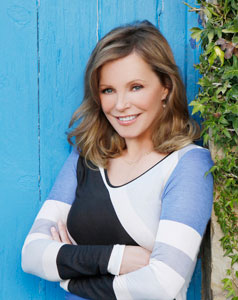![]()
 The actress Cheryl Ladd.
The actress Cheryl Ladd.
Photo Credit: Caroline GreyshockCHICAGO— June is Cataract Awareness Month, and eyecare professionals and others are underscoring the need for better education of the public as to the risk factors, symptoms and treatment options for cataract, which is the leading cause of blindness in the world.
In “Future of Vision: Forecasting the Prevalence and Costs of Vision Problems” by Prevent Blindness, “the current number of those in the United States with cataract will increase from more than 25.7 million, to 38.5 million by 2032, and then to 45.6 million by the year 2050. Cataract is a clouding of the eye’s lens which blocks or changes the passage of light into the eye.”
Several possible risk factors for cataracts include age, intense heat or long-term exposure to UV rays from the sun, certain diseases such as diabetes, hereditary factors, smoking and long-term steroid use.
However, unlike many eye diseases, vision loss due to cataract can be restored. Cataract surgery is one of the most commonly performed procedures in the U.S. According to the National Eye Institute, in approximately 90 percent of cases, people who have cataract surgery have improved vision.
For those interested in conducting discussions or seminars on the subject, Prevent Blindness offers a free online course on cataract as part of the “Adult Eye Disorders” module including a PowerPoint presentation with a complete guide as part of its Healthy Eyes Educational Series.
In a related move, to boost awareness about cataracts, Alcon, a division of Novartis, has partnered with actress Cheryl Ladd to launch the Know Your Cataract EYE-Q campaign, which seeks to educate consumers about the condition and challenges of cataract by testing their knowledge of the disease and learn about cataract treatment options.
“My husband previously had cataract surgery and during the process we realized how little we both knew about the condition and procedure—we found out that there are a lot of misconceptions about cataracts,” said Ladd. “It was important for both us to increase our Cataract EYE-Q so we could ask the right questions to inform our decision making process. I hope my personal journey will inspire others to equip themselves with the information needed to talk to their doctor.”

In a 2016 U.S. survey of approximately 1,000 adults aged 60 and over who have been diagnosed with cataracts, only 25 percent of respondents said they had a full understanding of the condition.
Survey results from Know Your Cataract EYE-Q indicated one in five (20 percent) thought there were other options besides surgery to treat the condition. Nearly half (45 percent) of respondents did not know whether cataract are preventable or not. Additionally, the survey showed that three in four (75 percent) respondents did not realize cataract surgery can also correct other vision conditions such as astigmatism.
“Cataract surgery is one of the safest and most frequently performed procedures each year, requiring little recovery time or inconvenience to patients' daily lives,” said Edward Holland, MD, director of cornea services at Cincinnati Eye Institute. “In fact, recent advances in lens technology and treatment options make it possible to correct cataract as well as other vision conditions and can help reduce the need for corrective glasses or contact lenses following surgery."